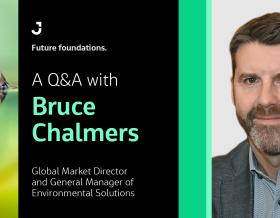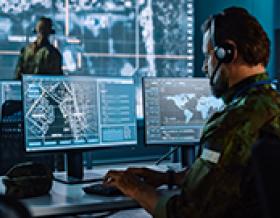
Royal Australian Air Force (RAAF) veteran Andrew Dunstone joined Jacobs at the end of January and is contributing to Australia’s national security by supporting the RAAF to conduct weapons tests in some of the most remote locations in the world.
Hi, Andrew. Can you tell us how the work you do is helping solve our clients’ biggest challenges?
As a Range Safety Engineer working with the Air Force Test Ranges Squadron, I am responsible for providing specialist engineering support for trials at the Woomera Test Range in South Australia, which is the largest land-based weapons test range in the world. I also support operation of the Delamere Weapons Range in the Northern Territory and a couple of other ranges dotted around Australia. My role is to use my in-depth knowledge of weapons testing and safety systems to develop a safe way to undertake complex weapons test activities. It is a challenging area as we see the desire from Australian Government Department of Defence (Defence) to apply new and innovative ways to rapidly increase its capabilities where timelines that were once measured in years are now being reduced to months.
A large part of my role is identifying and mitigating risks associated with test activities. This involves travelling to the ranges to show prospective users the facilities, identifying deficiencies and discussing hazards along with proposed mitigations. This is why we need to travel to remote locations such as Woomera and Maralinga – and even more isolated locations in the future as we engage with the Traditional Custodians, local government and landholders as Defence expands its test capabilities. As Australia brings new capabilities into service through arrangements like AUKUS and the Guided Weapons and Explosive Ordnance Enterprise, the importance of having highly capable ranges to conduct testing is critical.
Tell us about Woomera Range.
The scale of the Woomera Range is difficult for most people to comprehend. It is 122,000 square kilometers, or roughly the size of England. Simple things we normally take for granted like access to water, food, accommodation, power, internet, phones and fuel are not available in most locations on the range. Over the past few years, the range has had significant upgrades to facilities and range instrumentation. An important part of the new instrumentation is that it is portable, allowing it to be used anywhere it is needed – including other Defence range facilities.
It may also come as a surprise to know that Defence owns a relatively small area of the Woomera Range with the remainder being operated under state government leaseholds or owned by the Traditional Custodians. This results in the range being split into different regions that involve many non-Defence stakeholders including the Traditional Custodians, farmers with working pastoral leases and various mining operations. The Stuart Highway and Ghan Railway also run through the middle of the range. All these stakeholders must be considered and consulted when planning test events.
How do you ensure success in such remote locations?
Working in remote locations requires a great deal of preparation and planning. The township of Woomera, which is the base of our operations, is extremely isolated with the nearest supermarket an hour away in Roxby Downs. But we go even further into the desert than Woomera.
When we head out to Maralinga and beyond to set up a site to support testing, we can hire the whole village in consultation with the Traditional Custodians, the Maralinga Tjarutja people. This is something that can only be done in person to truly understand the complexities and requirements to successfully support a test event. Getting to Maralinga takes two days by car from Adelaide – and it’s still in the state of South Australia! On this journey we often swap vehicles at Woomera and get specially equipped 4 x 4’s with extended-range fuel tanks and recovery equipment for the drive along the track that parallels the Indian-Pacific railway. Dodging camels, snakes, kangaroos and “Kamikaze” emus while negotiating some challenging dirt roads makes for an interesting journey.
How do you stay safe?
To ensure the safety of everyone involved, it is critical to be prepared – we have to take food, fuel, camping equipment, lots of water, medical kits, etc. It is essential to have a strong understanding of the hazards of operating on the range in such remote areas and risk-mitigation strategies are required. For example, we travel in a convoy of a minimum of two vehicles, each fitted with radios and satellite phones, and ensure we have all the off-road equipment we need to stay safe.
Operating in a remote environment also requires investment in training. Most of the Commonwealth staff who spend time at Woomera have advanced first aid qualifications. Understanding how to correctly drive a 4 x 4 vehicle on dirt tracks is also highly recommended. Coming from a Defence background, I am lucky that I already had very good first aid knowledge plus significant 4 x 4 training and experience. For test events, medical planning is a critical consideration. The hazards of a remote location combined with potentially hazardous testing mean it is important that suitable medical services are available – this can range from having a dedicated evacuation vehicle through to on-site medical staff, as well as a dedicated medical evacuation helicopter.
“Getting to Maralinga takes two days by car from Adelaide – and it’s still in the state of South Australia! Dodging camels, snakes, kangaroos and “Kamikaze” emus while negotiating some challenging dirt roads makes for an interesting journey.”
What has been your most memorable experience in the Outback?
The most memorable experience from my first trip to Maralinga was being in a village that was created in the middle of Australia purely for the testing of nuclear material. Considering its remoteness, it must have been an amazing feat of engineering to carve out a town and 2,200 meter (~7,283 foot) concrete airstrip in the early 1950s from essentially nothing. Even today, the airstrip is in perfect condition – except for the occasional camel skeleton – with all the water for the town being sourced from rain runoff from the runway and apron. As someone with a strong interest in history, I felt privileged to visit Maralinga to see an area that has so much meaning for the Traditional Custodians and many former Defence personnel.
About the interviewee

Andrew Dunstone joined the Royal Australian Air Force in 1990 and completed a degree in aerospace engineering before specialising as an armament engineering officer. He has significant experience in aircraft stores compatibility and testing, as well as aircraft weapons acquisitions.
Join #OurJacobs team
What drives you drives us as we work to build a better world – together. At Jacobs, every day is an opportunity to make the world better, more connected, more sustainable. We’re always looking for dynamic and engaged people to join our team. Bring your passion, your ingenuity and your vision.











.jpg?h=c7c14dee&itok=FmPI2126)


















_0.jpg?h=8a6d63f3&itok=5vsqFiQH)









.png?h=1314d3d4&itok=rFs9mG95)



















